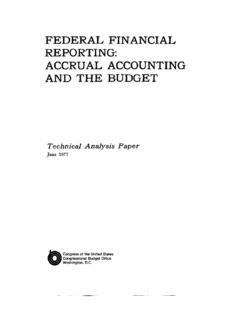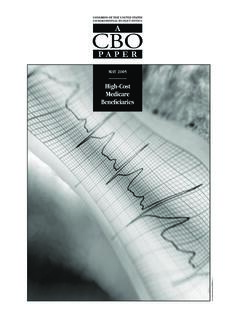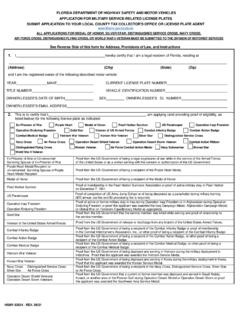Transcription of Department of the Army - Congressional Budget Office
1 CBOCHAPTER2 Department of the ArmyOverviewThe Department of the Army includes the Army s active component; the two parts of its reserve component, the Army Reserve and the Army National Guard; and all federal civilians employed by the service. By number of military personnel, the Department of the Army is the biggest of the military departments. It also has the largest operation and support (O&S) Budget . The Army does not have the largest total Budget , however, because it receives significantly less funding to develop and acquire weapon systems than the other military departments Army is responsible for providing the bulk of ground combat forces. To that end, the service is orga-nized primarily around brigade combat teams (BCTs) large combined-arms formations that are designed to contain 4,400 to 4,700 soldiers apiece and include infan-try, artillery, engineering, and other types of The Army has 30 BCTs in the active component and 26 in the National Guard (there are none in the Army Reserve).
2 It has no plans to change those numbers over the next five years (see Table 2-1). The vast majority of the Army s support units exist to support combat operations by BCTs, and the vast majority of the Army s administrative units exist to create, train, and maintain BCTs and their support The current organization of the Army into BCTs is a change from historical practice. Before the mid-2000s, when the service launched a modularity initiative, the Army was organized for nearly a century around divisions (which involved fewer but larger formations, with 12,000 to 18,000 soldiers apiece). During that period, units in Army divisions could be separated into ad hoc BCTs (typically, three BCTs per division ), but those units were generally not organized to operate independently at any command level below the division . (For a description of the Army s command levels, see Box 2-1.) In the current structure, BCTs are permanently organized for indepen-dent operations, and division headquarters exist to pro-vide command and control for operations that involve multiple Army is distinct not only for the number of ground combat forces it can provide but also for the large num-ber of armored vehicles in its inventory and for the wide array of support units it contains.
3 Those support units include units with significant firepower, such as artillery brigades (which have missile launchers as well as tradi-tional cannon artillery), aviation brigades (which have attack, reconnaissance, utility, or cargo helicopters), and other combat arms (such as Patriot missile launchers to defend against other missiles and aircraft). Army support units include many other types of specialized units, such as construction engineers, military intelligence, military police, and the Army s extensive logistics apparatus. Many of those types of units are responsible for support-ing not just Army units in the field but all of the other services in a combat operation. For example, the Army is generally responsible for all theater logistics functions, port operations, and enemy prisoner-of-war detention those combat and support units, the Army con-tains a number of smaller organizations that provide niche capabilities unrelated to BCTs.
4 Two noteworthy examples are the Army s special-operations forces (units such as the 75th Ranger Regiment, the 160th Special Operations Aviation Regiment, and the seven Special Forces Groups), and the Army s responsibility for 1. Formations, such as BCTs, that contain a mix of different types of units are referred to as combined arms. Such formations offer advantages over homogenous formations because the different types of units can complement one another and help offset the limitations of any single type of unit. Although all BCTs include a mix of unit types, it is customary to refer to them by their predominant type of combat As noted in Chapter 1, support can have a wide variety of mean-ings in the military, and whether a unit is generally considered a combat unit or a support unit does not mean that it always plays that role in a particular operation. For more details, see Box 1-1 on page MILITARY S FORCE STRUCTURE: A PRIMERJULY 2016 CBOT able of Major Combat Units in the Army, 2017 and 2021 Source: Congressional Budget Office , using data from the Department of Defense s 2017 Budget the Ground-Based Midcourse Defense portion of the national missile defense system (both of which are discussed in Chapter 5).
5 Distribution of Army PersonnelOf the nearly 1 million military personnel serving in the Army as a whole, roughly half are in support units and a third are in combat units (see Table 2-2). The rest belong to units that perform various overhead functions, such as recruiting, training, and equipping combat units. The Army s reserve component is slightly larger than its active component, with 54 percent of the service s total the 1970s, the Army has interpreted the Depart-ment of Defense s Total Force Policy which involves treating a service s various components as a single force by concentrating combat units in the active component and support units in the reserve component. Over the 2017 2021 period, the Army plans to have an average of 59 percent of its combat personnel in the active compo-nent and 75 percent of its support personnel in the reserve component. The practical effect of that distribu-tion is that the Army has enough support units in its active component to conduct relatively small operations on its own, but larger combat operations usually require it to mobilize a significant number of reservists to provide support for the active-component combat units as occurred during the occupation of Iraq.
6 (For more discus-sion of the implications of that structure, see the special-topic entry about integration of the Army s active and reserve components on page 38.)Command Levels and UnitsThe Army s combat units are organized in a recursive pattern: A unit at any command level contains two to five subordinate units of a similar type, plus additional sup-porting units. For example, an infantry brigade has two or three infantry battalions, a cavalry squadron, and a single battalion each of special troops, artillery, engineers, and Similarly, an infantry battalion has three infan-try companies, a heavy weapons company, and a head-quarters company. That pattern is repeated at lower levels (a company consists of platoons, and platoons consist of squads) and at higher levels (a division consists of brigade combat teams, and a corps consists of divisions), as detailed in Box 2-1. However, some command levels have different names depending on the type of unit; for instance, cavalry squadrons are at the same command level as infantry analysis treats supporting units as directly connected to combat units in a fixed relationship, but that treatment is an approximation that is valid only when discussing force planning.
7 In actual operations, most support units are assigned to higher command levels, which give them specific missions. A BCT does not include the support units that the Congressional Budget Office attributes to it in this analysis those units are division -, corps-, or theater-level assets that would be deployed to support the BCT and without which the BCT could not function. Furthermore, although the Army s plans involve main-taining a given set of units in the force structure, the commander of a specific operation can, and often does, tailor the mix of support units that are deployed to suit the circumstances of a particular theater of operations. For example, during the occupation of Iraq, the Army generally did not deploy artillery or air-defense units, although it had them in its force structure. Such units were considered unnecessary in that operation, and some were converted to perform roles deemed more useful dur-ing the occupation, such as protecting supply Brigade Combat TeamsActive component3030 National Guard2626 National GuardI n fan try Brigade Combat Te amsActive componentNational GuardS tryke r Brigade Combat Te ams2021 Armore d Brigade Combat Te amsActive componentNational GuardActive component20173.
8 Cavalry units are units that perform the same armed recon-naissance role once carried out by troops on horseback. Today,cavalry units are equipped with helicopters, tanks, armoredfighting vehicles, or wheeled 2: Department OF THE ARMYTHE MILITARY S FORCE STRUCTURE: A PRIMER19 CBOH istorically, ground combat units have been classified using weight-related terms, which reflect the weight of the units equipment and their commensurate speed and ability to maneuver. For decades, the Army broadly classi-fied its forces in that way: Armored and mechanized infantry units, which had the heaviest armored vehicles, were considered heavy forces, whereas infantry , air-assault, and airborne units, which had only a few or no armored vehicles, were considered light forces. Today, the Army has three types of brigade combat teams, which are roughly analogous to heavy, medium, and light forces armored BCTs have large numbers of the heavi-est armored vehicles, Stryker BCTs have large numbers ofBox Levels of Ground ForcesThe Army and Marine Corps are generally organized as hierarchies of units, with each type of unit com-manded by a noncommissioned or commissioned officer of a specific rank.
9 (Officers of other ranks play essential roles in those units but typically do not command them.) Those units are described here from smallest to largest:Squad/Section: A squad is commanded by a sergeant and has 4 to 12 personnel. A section is a group of vehicles, generally two in : A platoon is commanded by a second lieu-tenant and includes varying numbers of subordinate squads or sections. It has 16 to 50 personnel. Heavy platoons have four armored vehicles (such as tanks or infantry fighting vehicles, depending on the type of platoon).Company/Troop/Battery: A company is com-manded by a captain and includes two to five subordinate platoons (usually three or four). It has about 60 to 200 personnel. Heavy companies have 14 armored vehicles. Cavalry companies are called troops; artillery companies are called : A battalion is commanded by a lieutenant colonel and usually includes three to five combat companies and one support company. It has about 400 to 1,000 personnel.
10 Heavy battalions have 58 armored vehicles. Cavalry battalions are called Combat Team/Functional Support Brigade/Regiment/Group: A brigade is commanded by a colonel and is generally configured as either a brigade combat team (BCT) or a functional support brigade (FSB). A BCT has about 4,400 to 4,700 per-sonnel, depending on whether it is an armored, Stryker, or infantry BCT. An FSB has about 3,000 to 5,000 personnel, depending on its type (of which there are 20). Cavalry brigades are called regiments; some types of support brigades are called groups. Marine Corps units at this level are also called regi-ments. (The term Marine expeditionary brigade refers to a task force, which is larger.) division : A division is commanded by a major gen-eral and includes two to five BCTs (usually four), an aviation brigade, an artillery brigade, an engineer brigade, and a logistics brigade. Divisions have about 12,000 to 16,000 : A corps is commanded by a lieutenant general and includes two to five divisions and numerous support brigades and commands.














